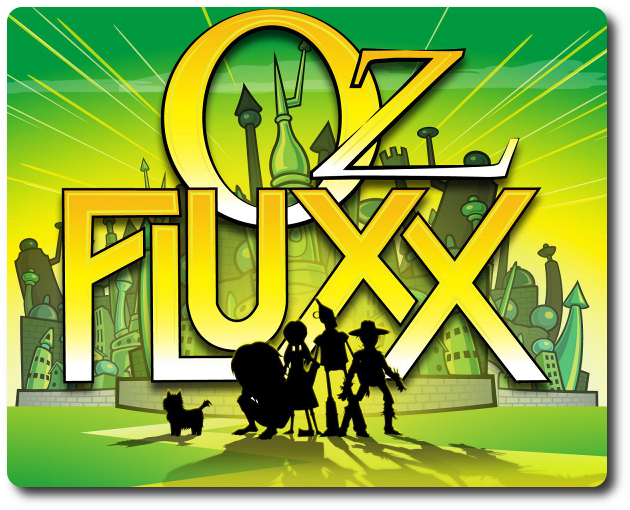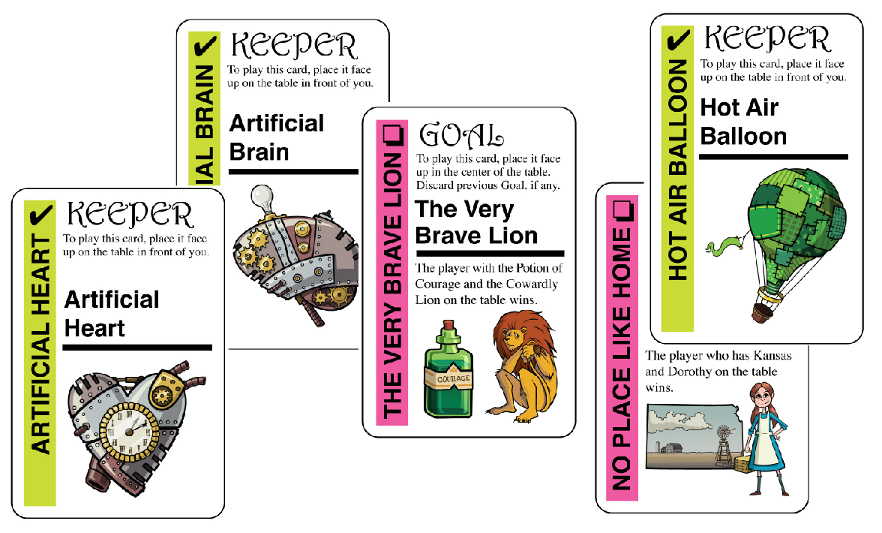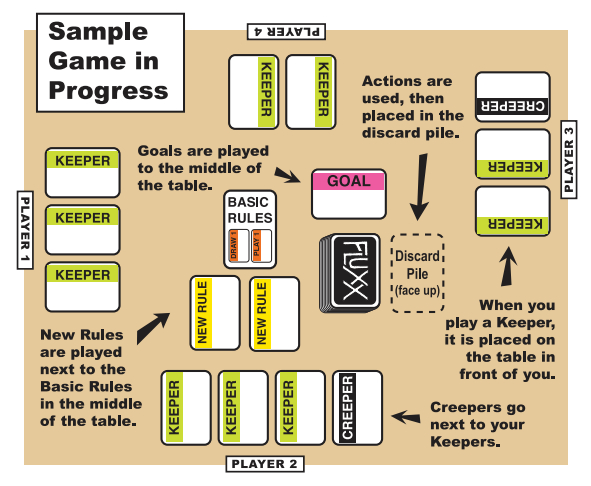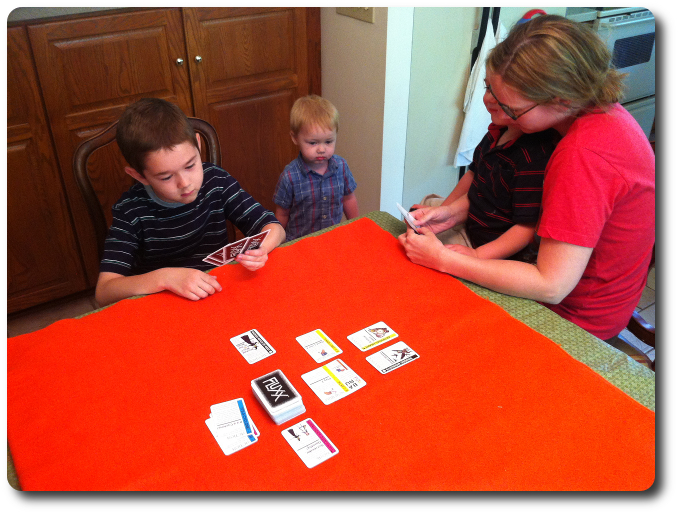
The Basics:
- For ages 7 and up (publisher suggests 8+)
- For 2 to 6 players
- Variable game length time (anywhere from 10 to 40 minutes)
Geek Skills:
- Active Listening & Communication
- Counting & Math
- Reading
- Pattern/Color Matching
- Hand/Resource Management
Learning Curve:
- Child – Variable
- Adult – Easy
Theme & Narrative:
- Be whisked away to the magical land of Oz then prepare yourself for an onslaught of chaos
Endorsements:
- Gamer Geek rejected!
- Parent Geek approved!
- Child Geek approved!
Overview
Oz Fluxx is the newest addition to the Fluxx family of card games from Looney Labs. The game doesn’t break any new ground (for those who are already familiar with the Fluxx games), but like the card games before it, the theme of the game is really what it’s all about. All of your favorite classic Wizard of Oz favorites are here, from the most wicked of witches to that little dog who miraculously survives the whole movie. And like all the other Fluxx games, chaos is a given. You’ll never have a chance to get comfortable or complacent as the game constantly shifts and the Yellow Brick Road to victory twists and turns without rhyme or reason.
Oz Fluxx is comprised of 100 cards and all depict some element of the Wizard of Oz story. To play the game well, you must understand the rules (duh), but more importantly, you need to understand the six different types of cards in the game. You don’t need to know a thing about Oz.
Here’s is a quick description of each card type to help you understand how the game is played. Note that all the cards are very clearly labeled and describe what you can and cannot do with them. Even if you’ve never played the game before, by simply reading the cards, a player can play the game right out of the box with little difficulty.

Example of just some of the 100 cards in the game
New Rule Cards
Part of the “charm” of Oz Fluxx is the way the game’s rules can change many, many times during a single game. While it might seem an impossible task to keep track of all the different rules that could be played, the game handles that for you and saves you a nose bleed by making sure new rules trump old rules. For example, one rule could say “Draw 2 Cards” and then a new rule played could say “Draw 3 Cards”. The New Rule Card replaces the old card and is used by all the players until another New Rule Card is played and replaces it.
Goal Cards
These cards define the victory condition and are used by all the players in the game. But, like the New Rule Cards, Goal Cards can trump older Goal Cards. This means that a player could be exceedingly close to winning the game only to have to start over because the goal changes. Of course, this also means a player who is nowhere near victory could suddenly find themselves victorious when a new Goal Card is played and they meet the conditions stated on the card.
Keeper Cards
These cards represent things in the game and are used to meet the Goal Card’s victory conditions. Keeper Cards are played out in front of the owning player and are constantly matched to the current Goal Card to determine if the players are on the right track.
Creeper Cards
These are the bad cards in the game and always come into play as soon as they are drawn (unlike the Keeper Cards which can be kept in the player’s hand and secret). The Creeper Cards can keep you from winning the game and are usually passed to opponents through Action Cards. However, there are very specific Goal Cards that actually require you to have one or more Creeper Cards in play.
Action Cards
These cards are used and discarded, requiring the players to do whatever the card demands. Sometimes the card will only require the player who uses it. Other times, the entire table has to complete the action stated on the card. The Action Card can be a game changer or hardly even noticed. It all depends on when they are played, making them something of gamble and the single greatest source of second guessing in the game.
Surprise Cards
These cards are meant to be played either during a player’s turn or out-of-turn. Their single purpose is to cause other players problems, but they can also be used to cancel out other Surprise Cards. It all depends on when the card is played, which is described in detail on the Surprise Cards. For example, the “Canceled Plans” Surprise Card will discard a Goal Card when played out-of-turn or can be discarded during the player’s turn to discard the current Goal Card and force all players to discard a Goal Card in their hand. Like Action Cards, the value of the card is dependent on when it is played.
Game Set Up
To set up the game, first find the Basic Rules card. Place this in the center of the playing area. This card defines the starting rules in the game that all players must abide by until such time a New Rule Card is played and trumps it. After that, shuffle the remaining cards and deal out to each player a starting hand of 3 cards. If any player has been dealt a Creeper Card, they must immediately play it in front of them and are dealt a new card. Players should keep their cards that have not been played to the table hidden at all times.
The remaining cards are placed next to the Basic Rule card, face-down, and becomes the Draw Deck. Determine who should go first (usually awarded to the person who first draws a card) and begin play.
Playing the Game
All games start out with two simple rules. These are draw 1 card and play 1 card. Until a New Rule Card is played and either trumps one of those basic rules or adds to it, the players will do this on their turn.
Keeper and Goal Cards can be kept in the player’s hand, and should remain hidden until such time they are played to the table. Creeper Cards are always played to the table as soon as they are drawn. The player always gets to draw another card if they select a Creeper Card. If the player is very unlucky, they might draw more than one Creeper Card on their turn.
Or the player’s might not draw any cards at all. Again, it all depends on the rules of the game that are currently in play. On their turn, the players must comply with the rules that will state the number of cards the player draws, the number of cards a player can play, the number of cards the player must discard down to, and taking any additional action a Keeper Card might require. Along the way, a Surprise Card might jump out and change everything or keep it the same. As the game progresses, it changes and is never the same game twice.

Example of a game in progress – image taken from the game’s rules
Winning the Game
To win the game, a player need only successfully met the requirements of the current Goal Card. At any time a player does, they immediately win, even if it isn’t their turn. There are no points to count or scores to keep. By simply meeting the conditions of the Goal Card, the player is victorious.
To learn more about Oz Fluxx, see the game’s official site.
Prediction
For my little geeks, this is going to be a new game experience for them. They have never played a game that was designed to keep changing. They have learned to adapt to variable levels of game difficulty (Forbidden Island is a great example), but they have never played a game that changes it rules over and over again. For my 4-year-old, this game is not a possibility. He is able to play games that are straight forward and have a defined list of specific and sequential actions that need to be taken. I’m afraid his little mind would rollover like Toto playing dead if he were to attempt the game as an individual player. He is also not a strong reader yet which makes the game impossible to play. As such, he’ll be playing with me or another family member.
My 7-year-old, who is now a very strong reader and no longer a newbie board or card game player, should have zero issues playing this game. This brings me to our stated Learning Curve. For adults, it is very easy – simply read the rules of the cards and off you go. We gave the Learning Curve for Child Geeks a “variable” value. Depending on how often the rules change and their complexity, this rather simple game can become a strange mix of rules that might cause a level of confusion. For the most part, I doubt my little geek will have a problem. It is only after the rules begin to change that I expect to start seeing his grasp of the game shift between complete comprehension and slight befuddlement.
Oddly enough, I could not find a single Parent or Gamer Geek who had never heard of Fluxx before. They either responded to my news that they would be playing a Wizard of Oz themed Fluxx game with excitement or groans.
Teaching Oz Fluxx took all of 2-minutes and my little geeks and the rest of the party at the table were ready to play. Before we started, I asked my little geeks what they thought of the game.
“Really neat, Dad. I like how the game will be changing over and over again, but I know this will make it difficult to win.” ~ Liam (age 7)
“I’m ready to play on your team, Daddy! Let’s kick some butt!” ~ Nyhus (age 4)
Looks like everyone is ready to play! Let’s see if our journey is a successful one or we all get lost in the woods of confusion.
Final Word
For the record, I am not a lover of Fluxx, regardless of the game’s theme (even Zombie Fluxx does little for me). I first played the game with a demo team at Gen Con, of all places, and the individual teaching the game actually messed it up. Considering how simple the game is, that was an incredible feat in itself. The result of that negative experience, however, has left a bad taste in my mouth for the game ever since. It’s not that the game is bad, it’s just I have no patience for it. I will be the last one to suggest a game of Fluxx and the first to leave the table if the game is put on it. Now that this has been stated…
My little geeks loved the game and wanted to play it again as soon as we were done. What they really enjoyed was the fast pace of the game and the way it kept them interested by constantly shifting. They would lean into the table to see the cards being played and listen closely when the game rules changed. Because there is nothing a player can do in the way of tactics and strategy, my little geeks didn’t stress out from the game and effortlessly had a great time with everyone at the table. This was especially true when their father groaned when his certain victory was suddenly whisked away by a different Goal Card played by his loving wife.
Parent Geeks also enjoyed the game a great deal. The game is light, exceedingly accessible (as long as you can read), and keeps everyone at the table in the game. It’s a fun family card game that even non-gamers can get into. The Wizard of Oz theme was enjoyed and everyone had, at one time or another, hummed a song or two from the movie.
Gamer Geeks were a mixed bag on this one. Much like another popular card game, Munchkin, Gamer Geeks either loved it or hated it. Very few could take it or leave it. Oz Fluxx polarized the gaming table and the line between those who enjoyed the game and those who did not could have been spotted from the Moon is was so well-defined. For those who loved it, they found it to be a fun game that is silly to play and requires very little in the way of thought. For those who did not like the game, they found it to be a terrible bore and painful to play, requiring very little in the way mental awareness.
All the groups agreed on one thing, however, regardless of their feeling about the game. The Wizard of Oz theme was done well and the game could become exceedingly frustrating.

My 7-year-old waits while his brother and mom plan their next move – the 2-year-old just wants a snack
Gamer Geeks, you are either going to love this game or hate it. There is almost zero strategy in the game and the constant shifting makes it near impossible to use any meaning tactics or strategy. This makes the game an unpleasant experience for some and a wonderful joyride for others. Depending on your mood and your point-of-view on what makes a “good game”, Oz Fluxx will be on your radar as a game to play or in your crosshairs as a game to kill on sight.
Parent Geeks, this is a light game that is easy to teach. It is very family friendly and will require all the players to read and keep track of what they can and cannot do in the game at all times. There is hardly ever any downtime for any of the players as cards played require all the players to sometimes take an immediate action. For this and a number of other reasons, the game can be exceedingly chaotic and very frustrating. The charm of the game is also one of its biggest negatives. It is not stable. Do expect the game to go from simple to disorderly in only a few rounds and then back again. For some families, this mix of order and chaos will be a wonderful new experience. For others, it might have family members yearning for a traditional Euro with strict turn order.
Child Geeks, this is a game that will always keep you guessing and on your toes. The Wizard of Oz theme is a fun one and you’ll be enjoying all the characters from the story as they appear on the cards. Do expect to be frustrated at times as the game can take strange turns. You might be very close to victory only to suddenly have nothing available to make a goal. Regardless, you’ll have a good time and laugh as your friends and family cheer one moment and then grumble in disgust seconds later when a card is played. Don’t be surprised if you join them and groan or cheer just as loudly!
Oz Fluxx is all about adapting. The theme in the game is not a necessary one and does nothing to make the game any different from the other Fluxx games, but it does serve to draw people in. Regardless of what gets the player to the table, they are in for a wild ride. I continue to not like the Fluxx games, but I also admit that my dislike for them is based on personal preference and not a reflection on the game’s quality. Lots and lots of people have fun with the Fluxx games and Oz Fluxx will be a welcomed addition to those who do.
If you are not one of those who enjoy Fluxx, don’t bother getting Oz Fluxx. It’s Fluxx with a farm girl and a dog from Kansas.
This game was given to Father Geek as a review copy. Father Geek was not paid, bribed, wined, dined, or threatened in vain hopes of influencing this review. Such is the statuesque and legendary integrity of Father Geek.




Pingback: Father Geek » Cthulhu Fluxx Game Review
Pingback: Smash Up Game Review » Father Geek
Pingback: Fluxx: The Board Game Review » Father Geek